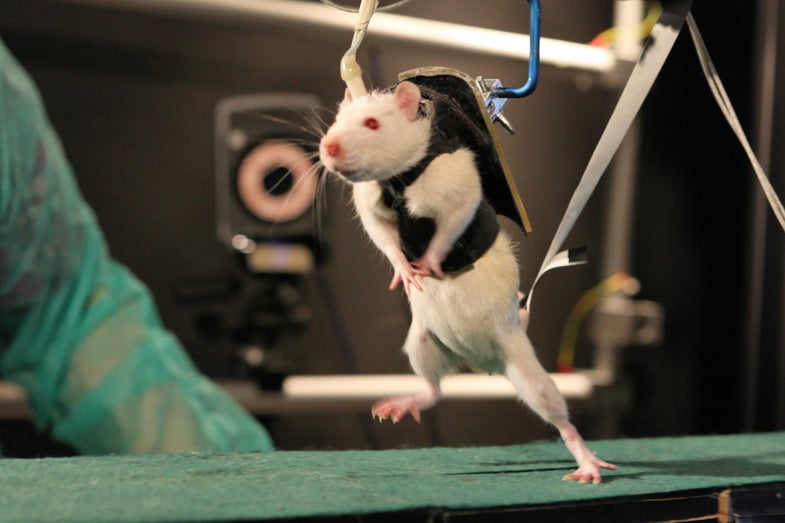Video: After Robot-Assisted Rehab and a Dose of Chemicals, Paralyzed Rats Walk Again
With careful training using a robotic harness, and a special chemical cocktail designed to stimulate brain cells, rats with spinal...

With careful training using a robotic harness, and a special chemical cocktail designed to stimulate brain cells, rats with spinal cord injuries were able to re-learn how to walk. Scientists in Switzerland say the tests suggest humans with paralysis due to spinal cord injuries may regain some nerve activity.
The therapy takes advantage of the nervous system’s inherent plasticity, in which neural networks can be rewired to take on different tasks. Areas of the motor cortex were able to establish new connections to the rats’ hind limbs, which had been paralyzed due to spinal cord injuries in a manner similar to spinal cord paralysis in people.
Despite the nervous system’s ability to reroute itself, half of human spinal cord injuries lead to paralysis, according to researchers led by Grégoire Courtine at the Swiss Federal Institute of Technology. But with a neural prosthesis, in this case an electrochemical treatment, and a robotic assistance device, even the most debilitating injury can be re-routed. The trick was rousing the dormant spinal column, the researchers say.
This is different from other robotically mediated paralysis therapy we saw recently involving brain-derived motor control. In that study, human patients wore a cranial device that tapped into their thoughts to control a robotic arm. In this case, the treatment is physiological, inducing dormant neurons to forge new connections and move limbs directly.
First, Courtine and colleagues injected the rats with a chemical cocktail that binds to dopamine, adrenaline and serotonin receptors on the spinal cord’s neurons. This replaced the neurotransmitters that would normally be released in healthy spinal pathways. A few minutes after priming the neurons, the team stimulated the rats’ spinal cords through electrodes implanted into the spinal canal. This sent electrical signals to the roused neurons. Then the rats needed to be trained to use their limbs again. Within a week of their injuries, the rats were on treadmills, forging new neural connections.

A Stroll in the Lab
Courtine and colleagues built a little rat vest that supported the animals as they stood on the treadmill. The vest stood them up on their hind legs, basically forcing them to use their paralyzed hind legs to walk upright. The rats tried to move toward a piece of chocolate on the other end, and gradually this “willpower-based training” built up new nerve fibers, the researchers say.
After two weeks of training, the rats took their first voluntary steps on their paralyzed legs. Within five or six weeks, all the rats in the study were able to walk bipedally, on their hind legs, for extended periods, Courtine et al. say.
“This is the world-cup of neurorehabilitation,” Courtine said in an EPFL news release. “Our rats have become athletes when just weeks before they were completely paralyzed. I am talking about 100 percent recuperation of voluntary movement.”
This is still a long way from working in humans, however. But human clinical trials are already on the horizon, set to start within two years in Zurich, according to EPFL.
The paper will be published in this week’s issue of Science.

Learning to Walk Again